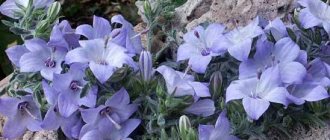The charming campanula is one of the most profusely flowering indoor plants. Touching and reverent, with bright greenery it is almost completely hidden under hundreds of pretty flowers and seems like a real blooming cloud. At first glance, you don’t immediately recognize indoor bells as relatives of garden bells. But these are the same plants, just adapted to pot culture. Growing campanula requires considerable effort and meticulous care. But all of them are more than compensated by the beauty of flowering.
Room bells. © Michael Bakker
Content
- History of the campanula 2 Description of the appearance of the plant 3 Caring for the campanula 3.1 Choosing a place for a pot with a flower 4 Temperature conditions 5 Required humidity in the room 6 Feeding 7 Caring for the flower in the autumn-winter period 8 The process of replanting the campanula 8.1 Methods of propagating the bell 8.2 Cuttings 8.3 Seeds 8.4 Dividing bushes 9 Fighting campanula diseases 9.1 Getting rid of pests
It's nice to have flowering plants in your apartment or garden. They create a pleasant atmosphere. For beginners, you can pay attention to such a flower as campanula..
It is easy to care for and does not require any special hassle or knowledge of floriculture. Due to the shape of the flowers, it is popularly called a bell. It is generally accepted that if campanula with blue and white flowers grows in the house, it will bring family happiness and good luck.
Note to the florist
Why doesn't Campanula bloom?
- Perhaps your plant is already old, its life cycle is ending. It is necessary to renew the flower by planting new cuttings in the pot in the spring.
- The reason for insufficient flowering may be a lack of light. Just move your campanula to a sunnier place. In summer, bells feel good in the fresh air - on the balcony or in the garden.
- A lack of microelements can also cause a lack of flowers. After all, a plant needs a lot of strength to bloom. Feed the plant once every two to three weeks with complex fertilizers for flowers. Just don’t overdo it; in this case, more does not mean “better.” To feed campanula, you can use complex fertilizer for flowering plants “Etisso” or “Kemira-Lux”.
Why does campanula wither?
- First of all, you should adjust the watering regime. Campanula does not like drought, but also does not tolerate excessive moisture and stagnation of water.
If you notice that the plant has become lethargic, and the soil is too wet and has an unpleasant odor, the root system may be damaged. The plant must be transplanted into a new pot, removing all rotten parts of the rhizome.
- If the light is too bright, campanula flowers quickly fade and wither. Shade your plant a little.
History of the Campanula flower, photos, varieties
It is difficult to determine the exact time of its appearance. Since ancient times, this flower has been a favorite indoor plant for women. It was also planted in flower beds near the house. The hanging shoots of campanula looked harmonious on the balconies. They were grown in special pots attached to the outside of the balconies.
The plant belongs to the bellflower family. Campanula (lat. Campanula) can be either annual or perennial. It is also found in the wild, for example, in the southern part of the European continent. Many species of Campanula have been cultivated and planted as ornamentals.
The varieties used for growing in the garden are: Alba, Maya, Makrantu, Bruntwood, Superba and Akulis.
Only a few of its species are primarily planted as indoor flowers. Campanula terry and equal-leaved Campanula isophyll are commonly used. Planting and caring for this plant is accessible even to novice gardeners.
Another popular hybrid is “Kent Belle”, which is a small bush with strong branching stems 20-40 cm in height. Unlike other varieties of bells, its flowers look like stars of a dark lilac color; you can see them in the photo above. Blooms all summer.
The indoor flower campanula is also called - bride and groom . The bride is the Campanula equifolia variety Alba with white flowers, and the groom is the Mayi variety with blue flowers. They are often planted in one pot, an example is shown in the photo below. According to popular belief, this decorative flower is considered the best gift for newlyweds, which will help to acquire family happiness and maintain love in a couple.
Varieties of colors
Types and varieties of decorative flowers differ in shape and leaf color:
| View | Leaves | Flowers and the period of their formation |
| Bogota | Long up to 10 cm, dark emerald. | The tube is red-yellow, scarlet, inside with bright orange and red stripes. They bloom in summer and bloom until autumn. |
| Red (grandmother's) | Dark green, covered with villi. | Large, red with beige specks. |
| Majestic | Top with light edge. | Large, sunny with bright scarlet dots, dark red stripes inside the throat. |
| Puffer-flowered | Oval, soft, dark. | Orange or scarlet. White, bright red dots, blooms all year round. |
| Koloskovaya | Gray, elongated, with a pointed end, with silver fluff. | An orange tube, yellow inside with scarlet dots. |
| Lindena (Gloxiella) | Narrow, elongated, up to 30 cm, pale pink below, green above, silver veins, herringbone-shaped. | Purple on top, orange petals with brown dots. Blooms in mid-autumn. |
| Foxglove | Long, light green, with red edging. | Hot pink with lilac stripes. The inside is light green with purple dots. Blooms in early autumn. |
| Pleasant | Wide, up to 10 cm, variegated with brown veins and streaks of silver color. | Red-pink on the outside, light on the inside with crimson speckles. Blooms all year round. |
| Tubiflora | Oval, pointed on top, red on the underside. | Intensely sunny, not expanded at the end. |
| Woolen | Large with light brown veining. | Beige with brown and white inside, beige splashes. |
| Dwarf (short) | Fluffy, with light stripes. | Bright, orange. |
| Hairy | Bronze shade. | Scarlet, lilac specks, burgundy. |
| Varshevich | Dark green, pointed on top. | Lilac, pink tube and yellow-green petals with brown, purple dots. |
| Uneven | Green, bright. | Red on the outside, speckled purple on the inside. |
| Flashdance | Bright green. | Large, coral, yellow with pink petals and fuchsia edging. |
| Jester | Green with a bronze tint, jagged at the edges. | Light with pink spots. |
| Carl Lindbergh | Pointed, serrated edges. | Dark lavender, covered with white dots. |
| Queen Victoria | Rich grass colors. | Pink, the tube inside is light with red speckles. |
| Red Reader | Dense, dark green. | Dark red with a white neck. |
| Roundley | Dark. | Orange, white inside. |
| Persian rug | Green, with a red border. | Velvety, red-raspberry with an orange neck. |
Campanula care
Have you decided to get yourself a plant like campanula?
Caring for a flower at home will not be difficult. The purchased campanula flower should be planted in a pot with a large diameter, since its roots grow quite quickly in width. Loose soil is required to ensure free growth of the root system. You can prepare a soil composition by mixing humus, leaf soil and sand in equal proportions.
Choosing a place for a flower pot
Campanula prefers a bright room. But growing in direct sunlight does not suit it. This can lead to gradual wilting, curling of the leaves and drying out.
If the plant does not receive sufficient lighting, the stems stretch and the distance between the leaves increases, which spoils the decorative appearance of the campanula.
The best option is a room with windows facing east. However, it is not recommended to place pots with plants on the windowsill. It is better to install a flower stand near the window opening. This will allow the flower to grow quickly. Soon the entire stand will be decorated with original bells.
Alternatively, you can hang a pot with campanula on the wall near the window.
With a change in the direction of the light flow, the campanula turns its open flowers towards it. It is not recommended to turn the flower in opposite directions, as this may negatively affect its flowering.
Temperature
It is necessary to protect the bells from extreme heat. In summer, you can take it out of the room. If this is not possible, then it is necessary to ensure a constant flow of fresh air. The most acceptable temperature for growing campanula is about 20-22 degrees.
In winter, it needs to be removed away from heating appliances and radiators, and also ensure that the air temperature near the flower does not rise by more than 15-20 degrees.
Required indoor humidity
Unpretentious campanula does not require a special moisture regime. It easily adapts to the usual irrigation regime. It does not require additional spraying or installation of special trays with water.
Spraying is used only in case of elevated temperatures. Abundant watering is required during the activation of growth and appearance of Campanula flowers. The soil is moistened abundantly, but the water should not stagnate.
In autumn, watering is reduced. One watering per week is enough. In winter, the plant requires even less moisture. Watering in the cold season is reduced to once a month.
If you did not have the opportunity to water the campanula in time, then do not worry. In the summer, a flower can survive without watering for up to 2 weeks. At the same time, the leaves and flowers do not dry out. But you shouldn’t experiment, as frequent breaks in moisturizing it can harm the bells.
Feeding
During the growth and flowering of campanula, you need to fertilize the soil in the pot. To do this, you can purchase fertilizers for flowering ornamental plants, for example, “Success” or “Master”. Instructions for use are included with the products. But there is no need to fertilize more often than every 2 weeks.
Flower care in autumn-winter
From the end of September, Campanula stops its growth phase. From this time until spring it is dormant. During this period, the plant needs moderate watering. Fertilizers are not applied in the autumn-winter season.
To preserve the decorative appearance of the bell, its elongated branches are trimmed. The lashes can be cut off, leaving only 10 cm in length.
The pot can be placed on the windowsill close to the cool glass. Such conditions are most comfortable for a campanula.
Maintaining the temperature regime and light is almost all that the campanula needs during the wintering period.
With the onset of spring days, you should water more intensively, and the flower pot should be placed in a warm place. Perhaps some branches will dry out. But don't worry - this is a normal process. Dry beds are removed.
When can you transplant and how to do it?
Gloxinia is replanted several times per season . Especially during the breeding season, as well as in the spring after wintering. During flowering, plants are transplanted only in the most extreme cases. The number of transplants also depends on the wintering method.
How to care for a plant in winter?
Gloxinias can overwinter in two ways - without digging and with digging.
- The first is resorted to when the plants are still young and have not been able to form sufficiently strong tubers. In this case, the plant should be watered moderately and illuminated. So that it continues to grow and enters a normal cycle by next fall.
- In the second case, by mid-autumn the plant dries out - leaves, stem, roots. Only the tuber remains alive, which must be preserved until spring. To do this in mid-October:
- the stem is cut at a height of one or two centimeters above the soil;
- after this, the stump is watered moderately for another two to three weeks, but not fed;
- no watering for another week;
- the tuber is dug up, cleared of soil, inspected and treated with any antiseptic.
You can store gloxinia tubers in winter in two ways - in the basement (10–12 o C) or in the refrigerator in the vegetable compartment. The tubers are placed in a bag and sprinkled with wet sand or a small amount of slightly damp soil mixed with vermiculite in a one-to-one ratio. The bag is sealed or tied. If the sand or soil dries out, it should be slightly moistened.
Tubers are stored in this way for up to three months. It is important not to allow them to germinate prematurely, since in this case the gloxinia will grow weak and will not bloom.
As a rule, new shoots and roots of gloxinia appear at the end of February or beginning of March . As soon as this happens, the nodules are removed from the bag and examined. Dry, diseased or unawakened tubers are discarded. For the rest, if necessary, dried or rotten parts are cut off, and the sections are treated with activated carbon. After which they are planted in new nutrient soil. It is not forbidden to treat them with a growth stimulant before doing this.
Campanula replantation process
Like most plants, campanula is replanted in the spring. There is no need to bother her with the procedure again. This is a kind of stress for the plant. Gardeners advise replanting into a large pot only if the flower does not have enough space in the old one.
Campanula transplantation is carried out as follows:
- a layer of pebbles is poured onto the bottom of the pot to provide drainage properties;
- then a soil prepared from equal amounts of sand, humus and leaf soil is placed;
- The plant is planted in the prepared soil and watered with water.
Preparing for landing
Before planting, seeds should be treated with a 1% solution of potassium permanganate for disinfection; they have good germination, so there is no need to use growth stimulants. After processing, they need to be dried with a dry cloth or napkin.
For planting, you can use a ready-made substrate for flowering crops or prepare the soil yourself. The optimal composition is fertile soil, humus and river sand in a ratio of 2:1:1. For planting, only a common container is required; bells are not picked.
Methods for propagating bells
Campanula can be propagated in three ways:
• cuttings; • seeds; • dividing the bush.
Cuttings
The simplest and most frequently used method of propagating Campanula domestica is using cuttings. This type of propagation is carried out in the spring, when the young shoots have reached 10-12 cm. The cuttings are carefully broken off and placed in a container with water or in well-moistened soil with a high sand content. As a rule, planted cuttings quickly take root and do not require special care.
The main thing is that the soil in the pot does not dry out and the air temperature is within 20-25 degrees.
After 2-3 weeks, the pot with a young campanula plant can be placed on the windowsill. An increase in light will give impetus to faster development and growth of the bush.
Seeds
Reproduction using Campanula seeds is also carried out in spring. It's better if it's early spring. Since the seeds are very small, they are sown in small containers and sprinkled with a thin layer of soil. Watering the seeds is not required. It is enough to lightly spray the soil until shoots appear. Seedlings should be planted in separate pots when they grow to 10-15 cm and have 3 leaves.
Dividing bushes
The division of the garden campanula bush is carried out after the end of its flowering. The dug out bush is divided into several parts, which are planted in prepared soil. For the garden type of campanula, this process must be carried out no later than September, because the plant needs time to take root.
Kinds
- Bluebell Peachleaf has a straight, slightly branched stem up to a meter high. The basal rosette leaves are elongated, serrated along the edges, the stem leaves are entire. The corolla is broadly bell-shaped, up to 4 cm in diameter, and can be white, blue or light purple in color. Blooms all summer.
Bluebell Peachleaf
- Carpathian bellflower is a hanging plant growing up to a maximum of 15 cm with small leaves and tiny single flowers, usually blue.
Carpathian bellflower forms a dense clump
- Bellflower Spreading - with a weak branching stem up to 50 cm long and narrow long leaves. Blue-violet flowers with curved petals are collected in panicles. Its flowering time is May-June.
- Bell of Portenschlag is a ground cover with stems up to 15 cm and serrated evergreen leaves. The flowers are purple, up to 3 cm in diameter.
Portenschlag's bell
- Ciliated bell is a miniature plant with a height of 7 to 15 cm and single flowers with a blue-violet color, light at the base, almost violet at the limbs. The leaves are oblong, with serrated edges.
Campanula ciliata
- Bellflower is an ampelous plant with numerous shoots and small round leaves with a serrated edge. From spring to autumn it blooms profusely with blue or white flowers with a diameter of 3.5 cm .
This is the only type of bells grown at home.
It is the Campanula equifolia that is grown as a houseplant
Controlling Campanula Diseases
The main cause of disease is improperly organized irrigation regime. With abundant and frequent watering, the plant begins to rot. The disease is called gray rot. Not only the root system is affected, but also the above-ground part. The soil begins to emit a foul odor.
At the first sign of a problem in Campanula, urgent measures must be taken. If the process began recently, then the plant can still be saved. It is necessary to cut off the parts affected by the putrefactive process, and then transplant it into another pot. Watering after transplantation should be reduced.
If the foliage of the Campanula has turned yellow, the watering regime is probably broken. This happens with both a lack and an excess of moisture. If the leaves begin to curl, this will indicate poor lighting or pest infestation.
Description of the range
Koleria grows in the shade of trees in tropical rainforests, as a shrub or subshrub, 60-80 cm high. The leaves are located on the stems one opposite the other. They are oval-shaped, elongated, the edges are jagged, pubescent, up to 18 cm long, 8 cm wide. The colors of the leaves are different: dark green, emerald with red veins. There are olive and light veins on them. Hybrid varieties have a silver, bronze color.
Unusual flowers (1-3 in an inflorescence) are asymmetrical, resemble a bell, the tube is up to 5 cm, the corolla is narrowed near the pharynx and swollen at the other end. The pharynx is open, decorated with speckles, dots or strokes, and has five lobes. Flowers can be one color, and the throat can be speckled in another. Blooms in July and blooms until the end of November.
The root system consists of rhizomes or tubers covered with scales. Externally similar to a pine cone.
Getting rid of pests
Campanula bellflower can be affected by spider mites and scale insects. Pest control should be carried out by spraying the plant with an insecticidal agent: Fitoverm, Sunmite or Flumite. They can be purchased in specialized stores. Instructions for use are indicated on the packaging of the product.
You can try to get rid of spider mites on campanula using home methods. The humidity in the room should be increased, since this pest cannot tolerate high humidity, and then the plant is sprayed with a soap solution. It is especially important that it falls on the lower part of the leaves.
Features of cultivation
Perennial bells have strong immunity and vitality, and are rarely affected by pests and diseases. As a rule, infection occurs when a flower is grown in one place for a long time, care technology is not followed, or there is an excess or lack of minerals in the soil. Diseases include both fungal and bacterial infections of roots. To prevent diseases for adult plants, it is recommended to treat them with a 0.2% solution of Fundazol in spring and autumn.
With high humidity, there is a risk of pests - the slobbering frog (leafhopper) and slugs. Large populations of these insects can be reduced mechanically, such as by removing them by hand. For control and prevention, both traditional methods (ash solution, infusion of garlic or onion) and chemical preparations are used - Aktara, Karbofos, Intavir and others.
Perennial bells are a real boon for the garden. The plant is unpretentious, develops quickly and blooms profusely almost all summer. To maintain health and flowering, minimal care should be taken. Due to the wide variety of species, this crop can be used for a wide variety of landscape design solutions.











